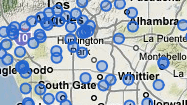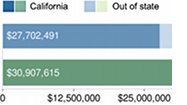Teacher responses to the 2010 release
The following is a list of teacher responses to their "value-added" ratings during the intial release in 2010. See the most recent responses »
The Times gave LAUSD elementary school teachers rated in this database the opportunity to preview their value-added evaluations and publicly respond. Some issues raised by teachers may be addressed in the FAQ. Teachers who have not commented may do so by contacting The Times.
|
|
 Delicious
Delicious
|
 Digg
Digg
|
 Facebook
Facebook
|
 Twitter
Twitter
|





When the statistical error average for these value added scores is 25% but the acceptable error average is 8 - 9%, how can these scores be useful? What is the point of printing this analysis when it is potentially so inaccurate? Couldn't a more truthful and reliable analysis have been used to enlighten the public? If the Times were my student, I'd have to give them a report card score of 2 (on a 1 - 4 scale). You tried but next time check your work a little more thoroughly first.
September 9, 2010 at 6:36 p.m.
While I do believe standardized tests can give valuable information about certain aspects of student progress, I do not believe that it tells the whole story. Student portfolios that show a progression of student work are much more valuable. While the Times indicates that standardized test scores should count for less than half of how a teacher’s effectiveness should be measured, that is not how the general public perceives these scores. It’s misleading not to include classroom-specific data along with these scores, such as whether the school departmentalizes subjects, how many students they typically have in a resource pull-out program, or how many students have an I.E.P. with testing accommodations. After reading other teacher responses, it seems many of the teachers with “Least Effective” status, including myself, didn’t even have all their students for the full day. My last year of teaching was also not included, even though I was there until late April 2007 before I left on maternity leave.
I taught at a School for Advanced Studies (SAS) in a non-SAS classroom. All four years I had the largest group of resource students in the fifth grade. For the first two years analyzed, I had an average of 8 students each year with I.E.Ps in resource pull-out for language arts, mathematics or both. These students were not in my classroom from 1 to 3 hours each day, receiving instruction for subjects reflected in my score. Many of these students had the testing accommodation of having the test read to them because of their learning disabilities. I typically had about the same number of English Language Learners from levels 2 through 5. Classes with this type of make-up require a lot of differentiated instruction where you have to look at the student’s specific needs and adapt your curriculum so that they can achieve grade level performance for all the content standards, including science and social studies.
While we did incorporate test-taking strategies into our curriculum, that was not our primary focus. For example, our grade level language arts goals focused on reading fluency and writing. Students can’t be successful in reading comprehension if they aren’t even reading at grade level. I wish my Open Court Scores were published as well, because they really showed how much progress my students made from September until June. We had an intense and comprehensive writing program where our students were producing grade level standards-based essays by the end of the year using Thinking Maps, including children who started fifth grade only being able to write a paragraph and use a simple web to brainstorm. Unfortunately my effectiveness for writing instruction cannot be measured on a Scantron. It wasn’t until my third year that we changed our language arts resource program so that the students stayed in my classroom full-time and I co-taught with the resource teacher. It’s very distressing that my fourth year wasn’t included because the co-teaching program was very successful. Furthermore, for all the years analyzed I was not the primary math instructor to the students pulled out of my class in the mathematics resource program and the Times notes that “Because there is more variation in math scores, very high or low performance in math counts for more.”
I was also the Science Lead Teacher and taught most or all (depending on the year) of the fifth grade classes science, including a review of fourth grade material before the science content exam. Our scores consistently rose and were above the state average. My teacher evaluations where an administrator observed my lessons were always meets or exceeds the standards. Ultimately, I believe teachers should have been given scores based on a comprehensive look at their teaching abilities across all the content standards. I totally agree that I can improve each year, as teaching is not a static profession; however, I do not believe my current score is an accurate reflection of my abilities as a teacher.
September 8, 2010 at 8:10 p.m.
It is interesting to view that I am deemed a less than effective teacher overall, however slightly higher in Math. I do not know what criteria was used to determine my effectiveness and how it actually relates to my students success. On state testing, I have scored higher than the state and higher than the district consistently for the past 3 to 4 years, so I do not understand how I can be less than effective. If I am less than effective and my scores surpass LAUSD's average score, than LAUSD is severely less than effective overall. This past year alone, 19/21 of my students were proficient or advanced in Math and 16/21 proficient or advanced in Language Arts including the ELD students that I had.
The success of my students on state testing is only a portion of my success. I am educating the entire child not only academically, but socially and emotionally as well. When it comes to a child, it's not only about the numbers.
September 7, 2010 at 1:46 a.m.
A very inaccurate rating of some of the finest teachers I know at a school with a 900+ A.P.I. How can you reconcile that with your scores when the state rates this school so high using the same statewide test results? Somewhere, somehow, something is skewed. But you sold a lot of newpapsers and created a lot of controversy with this presentation. You also damaged a lot of extremely professional, experienced and effective teachers. The positive, if I am "less effective" then I am in the company of the finest "less and least effective" teachers in the state. Fortunately I now teach in another state, at another 'highly performing' school full of teachers your review would undoubtedly find to be 'less effective'.
September 5, 2010 at 6:19 p.m.
Using Value Added Measure as an instrument to rate teacher effectiveness is a flawed and misleading means of evaluation. I am an effective educator. Every year I see tremendous growth in my students not only in the many standards based assessments they are given, but in their amazing written work, in the projects they are so proud of, and in their ability to articulate meaningful thoughts and ideas. When I see their eyes light up with the wonder and excitement of learning, I know I am effective. I know because I am respected by students, parents, colleagues, and administrators.
There is so much that goes into making an effective teacher. One of my former students visited me during the last school year excited to tell me she was off to college. She thanked me for helping her to believe that she was smart, and for encouraging her to work hard and to never give up. The ability to foster self confidence, responsibility, compassion for others, and to instill a lifelong love of learning is not reflected in a teacher’s Value Added Measure score.
The statistics used to manufacture a teacher’s score is another problem. Students are not randomly assigned to our classes. Student differences in learning styles, special needs, behavior, social/emotional issues, parent involvement, attendance, health/nutrition, and their home environment cannot be overlooked. These factors play a huge roll in how a student will perform on a standardized test. It is almost impossible to identify and give weight to these individual factors.
I am deeply concerned over the irresponsible level of journalism produced in your article. The inaccurate labeling of teachers throughout the district has damaged reputations and lowered morale. Many have been unfairly judged and devalued in your database. Teacher ratings based solely on standardized test scores, and value judgments such as “most effective and least effective” are counterproductive. Publishing the results with teacher names is outrageous. Creating a climate of fear in which teachers spend their time teaching to the test instead of developing long lasting critical thinking skills will prove damaging to the district and its students.
September 3, 2010 at 10:10 p.m.
Test scores are yet a small component of a teacher's effectiveness in the classroom, because no tool can measure an educator's overall effect on children - especially when some come to us with undiagnosed learning disabilities, while others arrive with other issues that affect learning, such as homelessness, abuse, neglect, and an absence of parental support. What measure is used to assess a teacher's 'value-added' effectiveness when addressing - and lovingly walking a child through - these profound problems?
Since the CST's have become a 'high-stakes test' for teacher evaluation, it should also be one for parents and students. Where is the parental accountability for making children study and do their homework? In addition, there are few consequences for students who have not met grade-level standards; they progress to the next grade because their parents usually have the last word on promotion- regardless of their teacher's recommendations.
A teacher's effectiveness simply cannot be measured by a bubble-in test. Beyond academics, children remember the love and encouragement and attention they receive from that educational professional who - in spite of the other 23 to 35 children in the room - strives to make each young person feel special. I have a hunch it's not the CST score that's important to each student at the end of their school year, but rather a spectrum of other elements that made their school year challenging and rewarding, and yes, even 'fun'.
But enough of my thoughts; after all, these opinions are only that of an 'average' value-added teacher with over a decade's classroom experience. To get some real perspective on this issue, I would suggest the L.A. Times do some truly ground-breaking journalism and ask the students what they think.
Like many of our students, you might be surprised what you learn.
September 3, 2010 at 1:57 p.m.
The Los Angeles Times used a flawed evaluation system to rate teachers. On the surface, it seems reasonable to use test scores to track a teacher’s performance. It is, after all, the same test that teachers administer throughout the district. Yet, test scores do not take into account many variables that affect student and teacher performance. I know a number of teachers that have had a tremendous positive impact on their students’ education and have been rated as average. There are also quasi-illiterate teachers that have been rated as most effective value-added. I will only recount my experiences here, as I was stamped with an average that has taken some of the passion out my teaching.
The same day that I was branded as average by the LA Times, I received my students’ test scores from the previous year. It was earlier in the day. I was so elated that tears came to my eyes. As background, you should know that these students were the ones that other teachers and the principal had basically written off. They were all English Learners. They had the lowest scores of their grade level. There were no proficient students, and most were Below Basic or Far Below Basic. I told my principal to give them to me. I knew I could help them, both as test takers and as lifelong learners. And I did. I began with twelve Below Basic students in Language Arts and ended with four Below Basics. I had five Below Basics in Math and ended with only one. Some students that I had looped with had started off with test scores of Far Below Basic. The first year they were with me, they moved up to Below Basic. This past year, they moved to Basic. Are these kids on standard? No. Have they worked tremendously and moved up significantly? Yes! To me, the Los Angeles Times has denigrated all the effort and progress that my students have made.
Another reason that using only standardized testing as a measure of teacher performance is flawed is that it takes no account of personal circumstances. Four years ago, I had cancer. I was diagnosed with cancer at the beginning of the year. After a series of tests, around mid-year, I had to take a leave of absence because of the chemotherapy and, later, because of surgery. I obviously also had a lengthy recovery. My students that year had four different “long term” substitutes. They had no stability and they did not receive the attention that my students usually get. Their test scores were bad. How deplorable that the LA Times would penalize a teacher for having cancer!
The standardized tests do not take into account the real achievements that students have made. My student M started off in my class reading an alarming four words per minute in third grade. Now, in fifth grade, she reads at around seventy words a minute. She is still below standard, but it was an incredible achievement for her. More importantly, this student now believes that she can be successful. My student J would cry when he had to write essays. By the end of the year, he begged to stay in during recess and lunch to keep writing. I received a long letter from one of my parents thanking me because, for the first time, her son was sure that his teacher cared about him and was willing to fight for him. My student L used to cry almost every day in her previous class. It took me half a year, but, after that, she began smiling, and, more incredibly, talking and participating. Students are not production units. Sure, I could do nothing but Language Arts and Math all year, take on a class with a lot of successful students, and be “more effective.” But, I did not go into teaching to just punch a clock. Nor did I decide to teach because I wanted an easy pat on the back. I have never expected olive wreaths from anyone, but I do demand balanced reporting from the LA Times.
September 3, 2010 at 9:55 a.m.
Sadly, I do not think you are showing a representation of test data that is accurate for students in the Third grade. You comment that students in Third grade notoriously drop in their scores, but you do not mention that they must read the entire test by themselves which is not what they must do in the Second grade. The Second grade test has several portions read aloud to the students by the teacher which certainly benifits struggling readers. Some Third graders come to me reading between 10 and 25 words correct per minute. The goal near the end of Third grade is 110 words correct per minute. Imagine the challenges for a student who has raised their total to 50-60 words correct per minute, but are expected to have a much higher rate to hopefully be successful on standardized testing. Also, what is the difference of most effective teachers? You limit your information on what the Times feels qualifies someone to meet this rating based soley on one piece of data. I hope you will at least take into account that this one test does not show an overall view of how all of my students scored as I had several who managed to rank in the Proficient and Advanced level again this year.
Respectfully,
Mrs. D. Kilroy
September 2, 2010 at 2:58 p.m.
The LA Times has evaluated LAUSD teachers in the 3rd, 4th, and 5th grades based on required state tests. In this process, did the researchers vet the tests that were used? If the tests were not validated by a team of independent experts, the data may be unreliable. Over the last few years, the educational community, itself, has questioned the content of some of these tests. Their concerns have led to changes in the tests focused on making evaluation of student progress more accurate. These changes indicate that flaws were found in the tests and in their alignment to state standards. It is unconscionable to publicly label teachers using data that may not be accurate. I remember a bunch of experts who led the nation down another questionable road by saying Iraq had WMD. LA Times, you need to be responsible. Do your homework!
September 2, 2010 at 12:46 p.m.
If this information is to be used to evaluate teachers, then that is fine, but first, it must be admitted that the presentation of this data is flawed. Secondly, if someone ever has an issue with my performance as a teacher then the professional thing to do would be to address it behind closed doors in the principal's office, and not in a newspaper. This is an act of desperation on behalf of the L.A. Times because journalism has a bleak future to say the least. Unless of course news can be generated at the expense of others. What did William Randolph Hearst say? "You furnish the pictures and I'll furnish the war." Only now it should say "You furnish the data and I'll furnish the war." I was fortunate enough (in this case) to have had good students whose scores could be raised through good instruction. Yes, it was hard work, but I feel that my colleagues work just as hard and are just as capable if not better teachers than I am. I constantly look to them for advice and ideas, yet they have been labeled, and will be viewed by future parents, as teachers who have average effectiveness on student performance. Why? Because they teach gifted students who constantly perform well, and thus there is little or no room for change in their scores. Please don't start labeling us until you truly understand what is we do on a daily basis and what the consequences of your actions will be.
September 2, 2010 at 12:08 a.m.